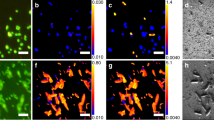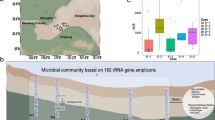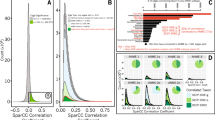Abstract
A large fraction of globally produced methane is converted to CO2 by anaerobic oxidation in marine sediments1. Strong geochemical evidence for net methane consumption in anoxic sediments is based on methane profiles2, radiotracer experiments3 and stable carbon isotope data4. But the elusive microorganisms mediating this reaction have not yet been isolated, and the pathway of anaerobic oxidation of methane is insufficiently understood. Recent data suggest that certain archaea reverse the process of methanogenesis by interaction with sulphate-reducing bacteria5,6,7. Here we provide microscopic evidence for a structured consortium of archaea and sulphate-reducing bacteria, which we identified by fluorescence in situ hybridization using specific 16S rRNA-targeted oligonucleotide probes. In this example of a structured archaeal-bacterial symbiosis, the archaea grow in dense aggregates of about 100 cells and are surrounded by sulphate-reducing bacteria. These aggregates were abundant in gas-hydrate-rich sediments with extremely high rates of methane-based sulphate reduction, and apparently mediate anaerobic oxidation of methane.
This is a preview of subscription content, access via your institution
Access options
Subscribe to this journal
Receive 51 print issues and online access
$199.00 per year
only $3.90 per issue
Buy this article
- Purchase on SpringerLink
- Instant access to full article PDF
Prices may be subject to local taxes which are calculated during checkout



Similar content being viewed by others
References
Reeburgh, W. S. in Dynamic Environment of the Ocean Floor (eds Fanning, K. & Manheim, F. T.) 203–217 (Heath, Lexington, Massachusetts, 1982).
Martens, C. S. & Berner, R. A. Interstitial water chemistry of Long Island Sound sediments. I, Dissolved gases. Limnol. Oceanogr. 22, 10–25 ( 1977).
Iversen, N. & Jørgensen, B. B. Anaerobic methane oxidation rates at the sulfate-methane transition in marine sediments from Kattegat and Skagerrak (Denmark). Limnol. Oceanogr. 30, 944–955 (1985).
Alperin, M. J., Reeburgh, W. S. & Whiticar, M. J. Carbon and hydrogen isotope fractionation resulting from anaerobic methane oxidation. Glob. Biochem. Cycles 2, 279–288 (1988).
Hoehler, T. M., Alperin, M. J., Albert, D. B. & Martens, C. S. Field and laboratory studies of methane oxidation in an anoxic marine sediment: Evidence for a methanogenic-sulfate reducer consortium. Glob. Biogeochem. Cycles 8, 451–463 ( 1994).
Hansen, L. B., Finster, K., Fossing, H. & Iversen, N. Anaerobic methane oxidation in sulfate depleted sediments: effects of sulfate and molybdate additions. Aquat. Microb. Ecol. 14, 195– 204 (1998).
Hinrichs, K. U., Hayes, J. M., Sylva, S. P., Brewer, P. G. & DeLong, E. F. Methane-consuming archaebacteria in marine sediments. Nature 398, 802– 805 (1999).
Suess, E. et al. Gas hydrate destabilization: enhanced dewatering, benthic material turnover and large methane plumes at the Cascadia convergent margin. Earth Planet. Sci. Lett. 170, 1–5 (1999).
Linke, P. et al. In situ measurement of fluid flow from cold seeps at active continental margins. Deep Sea Res. 41, 721– 739 (1994).
Bohrmann, G., Linke, P., Suess, P. & Pfannkuche, O. RV SONNE Cruise Report SO143: TECFLUX-I-1999. GEOMAR Rep. 93, (2000).
Aharon, P. & Fu, B. Microbial sulfate reduction rates and sulfur and oxygen isotope fractionations at oil and gas seeps in deepwater Gulf of Mexico. Geochim. Cosmochim. Acta 64, 233–246 (2000).
Elvert, M., Suess, E. & Whiticar, M. J. Anaerobic methane oxidation associated with marine gas hydrates: superlight C-isotopes from saturated and unsaturated C 20 and C25 irregular isoprenoids. Naturwissenschaften 86, 295–300 ( 1999).
Koga, Y., Morii, H., Akagawa-Matushita, M. & Ohga, M. Correlation of polar lipid composition with 16S rRNA phylogeny in methanogens. Further analysis of lipid component parts. Biosci. Biotechnol. Biochem. 62, 230–236 ( 1998).
Thiel, V. et al. Highly isotopically depleted isoprenoids: molecular markers for ancient methane venting. Geochim. Cosmochim. Acta 63 , 3959–3966 (1999).
Pancost, R. D. et al. Biomarker evidence for widespread anaerobic methane oxidation in Mediterranean sediments by a consortium of methanogenic archaea and bacteria. Appl. Environ. Microbiol. 66, 1126– 1132 (2000).
Amann, R. I., Krumholz, L. & Stahl, D. A. Fluorescent-oligonucleotide probing of whole cells for determinative phylogenetic and environmental studies in microbiology. J. Bacteriol. 172, 762– 770 (1990).
Amann, R. I. et al. Combination of 16S rRNA-targeted oligonucleotide probes with flow cytometry for analyzing mixed microbial populations. Appl. Environ. Microbiol. 56, 1919–1925 (1990).
Manz, W., Eisenbrecher, M., Neu, T. R. & Szewzyk, U. Abundance and spatial organization of Gram-negative sulfate-reducing bacteria in activated sludge investigated by in situ probing with specific 16S rRNA targeted oligonucleotides. FEMS Microbiol. Ecol. 25 , 43–61 (1998).
Ravenschlag, K., Sahm, K., Knoblauch, C., Jørgensen, B. B. & Amann, R. Community structure, cellular rRNA content and activity of sulfate-reducing bacteria in marine Arctic sediments. Appl. Environ. Microbiol. 66, 3590–3600 (2000).
Sahm, K., Knoblauch, C. & Amann, R. Phylogenetic affiliation and quantification of psychrophilic sulfate-reducing isolates in marine arctic sediments. Appl. Environ. Microbiol. 65, 3976–3981 (1999).
Devereux, R., Kane, M. D., Winfrey, J. & Stahl, D. A. Genus- and group-specific hybridization probes for determinative and environmental studies of sulfate-reducing bacteria. Syst. Appl. Microbiol. 15, 601 –609 (1992).
Rabus, R., Hansen, T. A. & Widdel, F. in The Prokaryotes: An Evolving Electronic Resource for the Microbiological Community (eds Dworkin, M., Falkow, S., Rosenberg, E., Schleifer, K.-H. & Stackebrandt, E.) (Springer, New York, 2000).
Fröstl, J. M. & Overmann, J. Physiology and tactic response of the phototrophic consortium “Chlorochromatium aggregatum”. Arch. Microbiol. 169, 129–135 (1998).
Mobarry, B., Wagner, M., Urbain, V., Rittmann, B. E. & Stahl, D. A. Phylogenetic probes for analyzing abundance and spatial organization of nitrifying bacteria. Appl. Environ. Microb. 62, 2156–2162 (1996).
Boone, D. R., Johnson, R. L. & Liu, Y. Diffusion of the interspecies electron carriers H 2 and formate in methanogenic ecosystems and its implications in the measurement of Km and H2 or formate uptake. Appl. Environ. Microbiol. 55, 1735– 1741 (1989).
Valentine, D. L. & Reeburgh, W. S. New perspectives on anaerobic methane oxidation. Environ. Microb. 2 (in the press).
Preuβ, A., Schauder, R. & Fuchs, G. Carbon isotope fractionation by autotrophic bacteria with three different CO2 fixation pathways. Z. Naturforsch. C 44, 397–402 ( 1989).
Fossing, H. & Jørgensen, B. B. Measurement of bacterial sulfate reduction in sediments: Evaluation of a single-step chromium reduction method. Biogeochemistry 8, 205– 222 (1989).
Snaidr, J., Amann, R., Huber, I., Ludwig, W. & Schleifer, K. H. Phylogenetic analysis and in situ identification of bacteria in activated sludge. Appl. Environ. Microbiol. 63, 2884–2896 (1997).
Stumm, W. & Morgan, J. J. Aquatic Chemistry 2nd edn (Wiley, New York, 1981).
Acknowledgements
The expedition SO143 was performed as part of the program TECFLUX, which addresses geophysical, biogeochemical and hydrographic processes associated with fluid venting from the Cascadia continental margin. The field work of TECFLUX’99 was jointly planned, coordinated and performed by the GEOMAR Research Center for Marine Geosciences at Kiel and the College of Ocean and Atmospheric Sciences (COAS) of Oregon State University, Corvallis. We thank these institutions for the invitation to participate. The TECFLUX programme is supported in Germany by the Bundesministerium für Bildung und Forschung and in the United States by the National Science Foundation. We thank the officers, crew and shipboard scientific party of RV SONNE for support at sea during the expedition SO-143, P. Linke and M. Elvert for providing some of the sediment samples, A. Kähler, T. Lösekann, H. Löbner and G. Tsounis for help with the SRR measurements, and J. Wulf for help with the micrograph photography. We thank C. Arnosti for corrections to the manuscript, and D. Valentine and W. Reeburgh for showing us their manuscript before publication.
Author information
Authors and Affiliations
Corresponding author
Supplementary Information
Rights and permissions
About this article
Cite this article
Boetius, A., Ravenschlag, K., Schubert, C. et al. A marine microbial consortium apparently mediating anaerobic oxidation of methane. Nature 407, 623–626 (2000). https://doi.org/10.1038/35036572
Received:
Accepted:
Issue Date:
DOI: https://doi.org/10.1038/35036572



